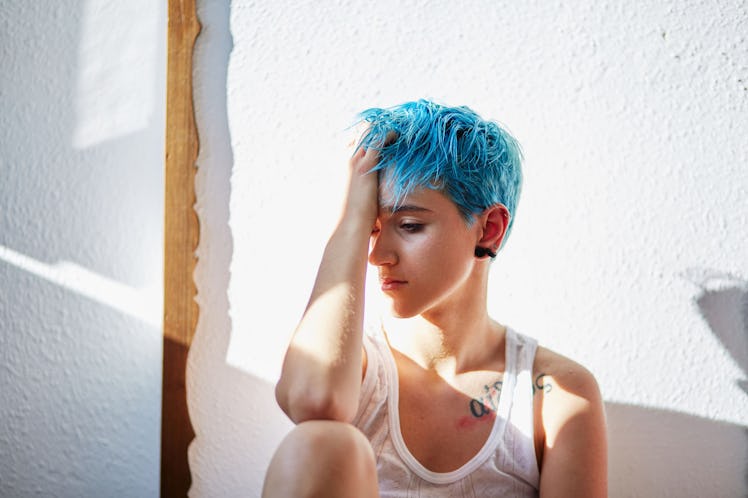
Here's The Real Reason Why Women Are More Likely To Get Migraines, According To Science
You're sitting on the couch scrolling through Instagram when a piercing pain, almost like a knife jabbing the right side of your brain, makes you drop your phone in your lap. You close your eyes, tilt your head back, and feel the skin literally throbbing. You try to stand up, but any sudden movements only intensify the pain. It can be hard to tell what triggers a migraine, but estrogen, the female sex hormone, is apparently the reason why women are more likely to get migraines than men — which would make sense, considering the female anatomy naturally contains more estrogen than a man’s body. And estrogen is a really powerful thing: It plays a significant role in your menstrual cycle, keeps your body temperature stable, regulates cholesterol and collagen production, and even preserves bone strength. But too much estrogen, according to new research, can backfire on the brain, leading to grueling migraines many women know and loathe all too well.
I’ve been pretty lucky in that I can count on one hand how many times I’ve had an actual migraine. I’ve had plenty of headaches (especially around my period), but migraines? Not so much. My sister, on the other hand, gets migraines constantly, and I can remember one of my best friends having to leave school early on multiple occasions because of migraines that were so bad, she'd often lose her vision whenever the pain set in. Maybe up until now, you’ve just been assuming migraines are super painful headaches. If you’ve never had one, how would you know, right?
Well, to clarify, according to Marcela Magda Popa, M.D., a board-certified internal medicine physician and author of the book Keep Away from GRAS: Generally Recognized As Safe, a true migraine isn’t just a really bad headache. In fact, it’s quite the complicated beast: Migraines, Popa tells Elite Daily over email, are a kind of pulsing sensation that usually takes place on just one side of the brain, last anywhere from one day to 72 hours, and can even be accompanied by symptoms like nausea, vomiting, and sensitivity to light and sound. What's more, she adds, any kind of physical activity, even something as simple as walking up the stairs, can easily make the pain worse. “Migraines usually start in early adolescence” she says, adding that “women are three more times more prone to migraines than men.” Lucky us, right?
To be even more specific, according to the Migraine Research Foundation's statistics, a whopping 28 million of the 38 million total Americans who suffer from migraines are women. And women aren't just more prone to migraines than men; according to the foundation, the way women experience migraines is, generally speaking, a lot worse, too. The foundation reports that women experience migraines that include more episodic pain (aka a quick onset of severe strain), as well as more chronic pain than men. So why do women get the short end of the stick here, you may ask? Because women simply have more estrogen in their bodies than men do.
While not all migraines are hormonal, this theory that estrogen is the reason why women have more migraines than men has been explored time and time again. Most recently, researchers from the Universitas Miguel Hernández in Spain published a review of several studies on the topic in the journal Frontiers in Molecular Biosciences that explored how different hormones are linked to the onset of migraines. Testosterone, the male sex hormone, was found to alleviate migraine symptoms, ScienceDaily reports, while a dip in estrogen was found to trigger migraines, especially in women experiencing either PMS or bleeding.
So now you might be thinking: why estrogen? Dr. Celine Thum, medical director at ParaDocs Worldwide Inc., tells Elite Daily that one theory is that estrogen controls certain chemicals in the brain “that alter one’s perception of pain,” while Popa adds that migraines that happen during menstruation, specifically, are more severe, intense, and perhaps even last longer, all because of a drop in estrogen levels “at the beginning of the menses,” otherwise known as estrogen withdrawal. And while Antonio Ferrer-Montiel, a researcher who worked on the Frontiers in Molecular Biosciences report, said in a statement that more research needs to be done on the subject, there’s really no denying that estrogen plays some part in women's migraines. Can I get a face-palm? Because this all sounds horrible to me.
Fortunately, there is some good news: Hormonal migraines can be treated, though Robert Glatter, M.D., assistant professor of emergency medicine at Lenox Hill Hospital, Northwell Health, does warn that, for reasons that still aren't totally clear to researchers, women’s bodies don’t typically respond as well as men's to migraine medication, which means it might take a while for you to find a treatment that works for your body.
So where can you turn to for relief? Popa tells Elite Daily that things like beta-blockers, antidepressants, or anticonvulsants (i.e. anti-seizure medications) are typically used to treat chronic migraines, while Thum suggests hormone therapy could be beneficial as well.
Ultimately, if you experience chronic, hormonal migraines, it's in your best interest to talk to your doctor and explore treatments that are right for you and your body. More often than not, estrogen is working for, not against your body, so in these cases, you just have to work with your body to give it the relief it deserves.